Photo

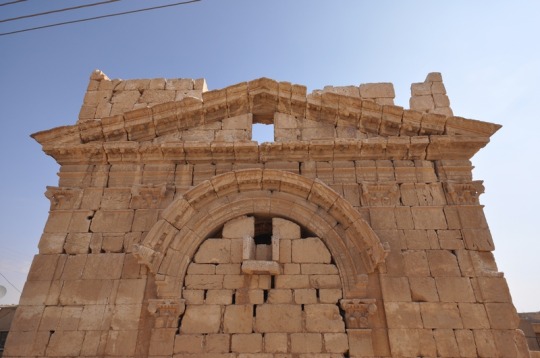



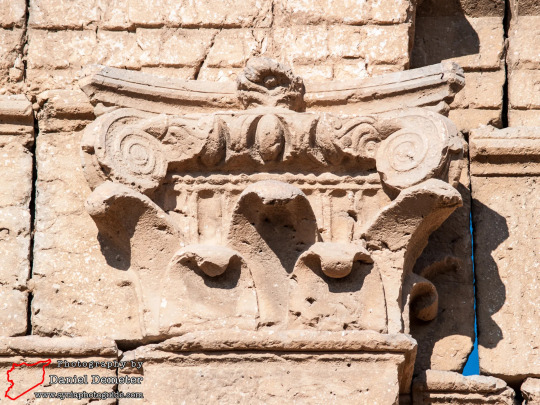
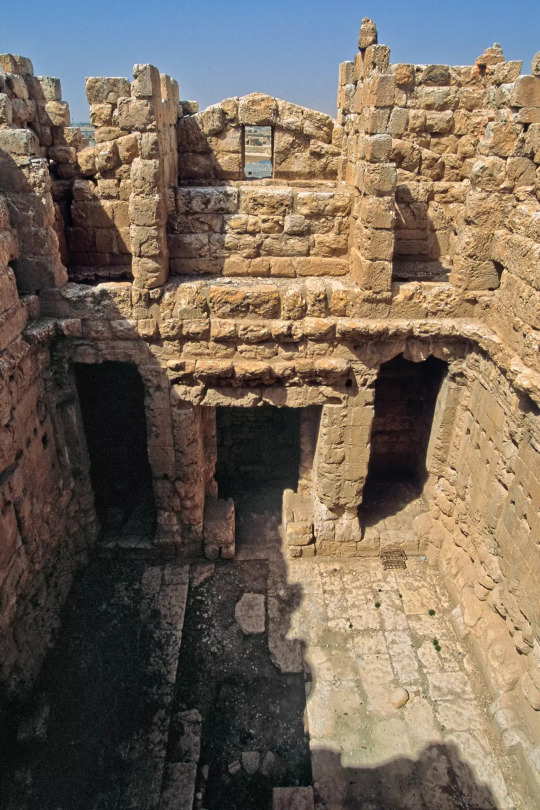

Temple of Zeus Hypsistos
Thelsea (Al-Dumayr, Syria)
94 CE (?)
The temple in Dumeir was a tetrastyle flat-façade temple with Semitic corner Towers. The temple was rededicated several times- one inscription mentions the not well-known deity Aeichala and another inscription, now in the Institut du Monde Arabe in Paris, documents that in the year 94, construction work took place. In this text, the deity is identified as Ba'al Šamem, the "lord of heavens". Later, the god was called Zeus Hypsistos, the Greek name of Ba'al Šamem.
Some modern scholars identify the group, or groups worshipping Hypsistos, with God-fearers mentioned in the Acts of the Apostles, gentile (non-Jewish) sympathizers with Second Temple Judaism.
The unusual building itself, essentially a monument with two gates, is perfectly preserved. It must have started as an enclosure surrounding a well.
While its construction date is unknown, it was probably a Nabatean building, likely converted to a temple around the 2nd century
In its present state, with walls standing seventeen meter high, the monument dates to the reign of Philip the Arab (r.244-249), who was born in the nearby Hauran region. Corner towers and staircases prove that rituals were performed on the roof, as was customary in Syria. In the Arab period, the building was converted to a fort, the gates being filled with stones.
*top reconstruction is by me, coloring based on references and not on finding on site.
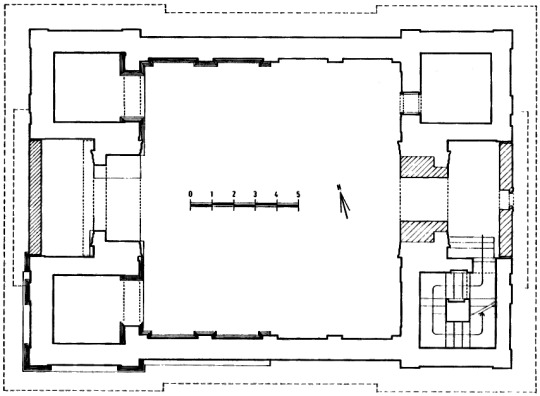

An interesting altar, now in the Louvre in Paris, offers a lot of information about the people. Its hexagonal shape betrays Roman influence, but the inscription is in Nabataean, a language related to Arabic. It informs us that the local mayor was called "general" and that family relations were quite complex: the altar is erected by one Hani'u, freedman of a lady named Gadilu, daughter of Bagrat and mother of two sons, who were adopted by her second husband, Abdmaniku the General. One these sons, Adramu, became General as well. (The other son was called Nakidu.) Interestingly, the Seleucid Era is called the Roman Era and equated to the regnal years of king Rabbel II of Petra, indicating the double identity of the people of Thelsae.



Sources: 1, 2, 3, 4
#art#Architecture#roman#Zeus Hypsistos#zeus#baal#Aeichala#Ba'al Šamem#composite#tetrastyle#tower#semitic#nabatean#arch#gate#inscription#eagle#altar
109 notes
·
View notes
Photo


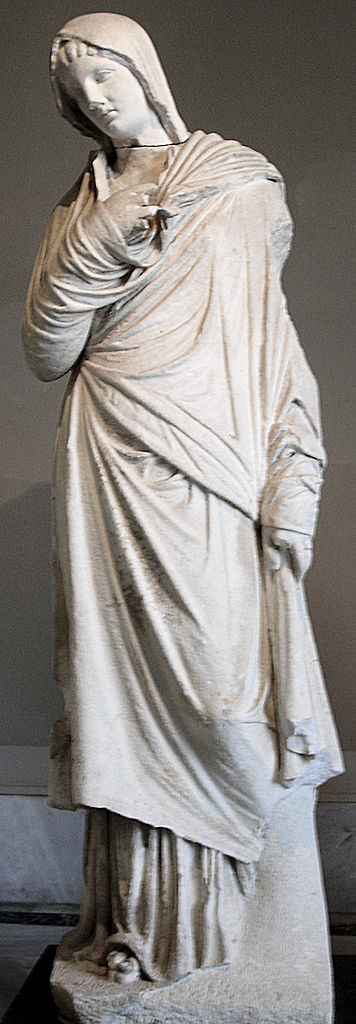
Arch of Caracalla
Thassos, Greece
3rd century CE
An Arch of Caracalla was excavated on the island of Thasos, on the south-western coast of Thrace, in 1886, 1911, 1953 and 1992-1993. The arch had three passages and was 16,85 m. wide and 9,5 m. high. Fragments were found of a colossal statue of a man struggling with a lion, presumably Hercules.
A dedicatory inscription, from the years 213-217 CE, was added by the city of the Thasians and lists Caracalla, Julia Domna, and the deified Septimius Severus. An earlier inscription was erased, so this might be a re-dedicated arch. The use of the accusative for the names suggests that three Imperial statues were erected. Statues of a priest and priestesses were placed on inscribed pedestals near the arch: of Julius Flavius Macedo, Memmia Belleia Alexandra, and Flavia Vibia Sabina. One complete statue, of Sabina, and fragments of the other statues were found.
The inscription of the Arch:

The greatest and holiest Emperor Caesar
Marcus Aurelius Antoninus Pious Augustus, Parthicus Maximus,
Britannicus Maximus, Germanicus Maximus, the city of
the Thasians. Julia Domna Augusta, the city of the Thasians.
The deified Lucius Septimius Severus Pertinax, the city of
the Thasians.
Source: 1
185 notes
·
View notes
Photo






Khirbet edh-Dharih
Jordan
100 CE
22x16 m
Dharih's Nabataean settlement can be roughly dated to around 100 CE. It flourished during a period of prosperity in times of the Roman annexation of the Nabataean Kingdom.
The temple (22 m x 16 m) consists of an unroofed vestibule to the south which opens to an almost square complex to the north, with a cultic platform in its center. The façade facing south was 15 meters high. It had two protruding pedestals that used to host statues on each side of the entrance door, and two large windows above them. The architrave was decorated with carved vines and animals, and had Medusa heads at the corners. The frieze above displayed figures of the Zodiac alternating with winged Victories, and the triangular pediment, sea centaurs crowned by flying Victories. Standing eagles guarded the central figures. While several of the mentioned figures can be seen at the Jordan Museum, the central couple of gods, Dushara and al-'Uzza, can only be guessed from fragments.
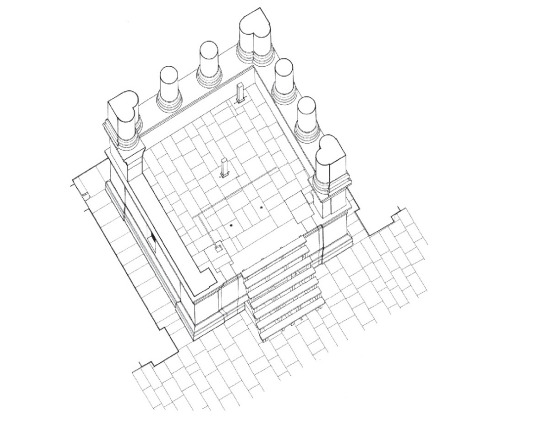

The columned podium (7 x 7 m, height 1.40 m) in the center is accessed through two narrow stairways in the front. In the central slab of its pavement is a rectangular hole flanked by two small circular ones. Beneath the slab, a stone basin was found. The excavators interpret this as a system for sticking a betyl, and collecting the offering liquid after the ritual libations. It is not clear if this would have been wine, oil, or even blood. In a later phase, further two betyl holes were added in diagonal, which indicates a cult of a triad of gods.
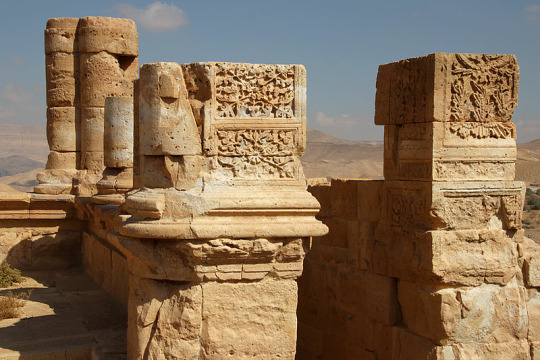

A narrow U-shaped corridor surrounds the podium on three sides to circumambulate it in ritual processions. The hallway also gives access to two crypts situated under the platform and to the corner rooms. The northeast one encloses a staircase that used to lead to a terraced roof, and the two on the northwest side have large wall cupboards.
It is assumed that the craftsmen of the Dharih temple were the same who decorated the temple on the peak of Jabal et-Tannur.

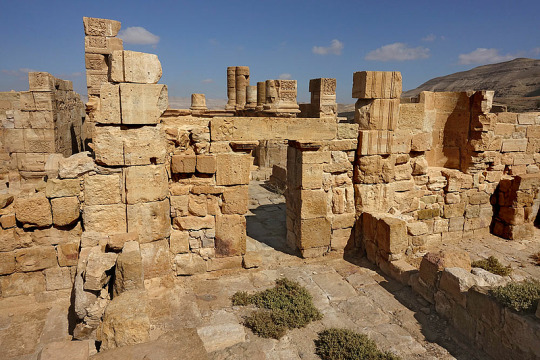

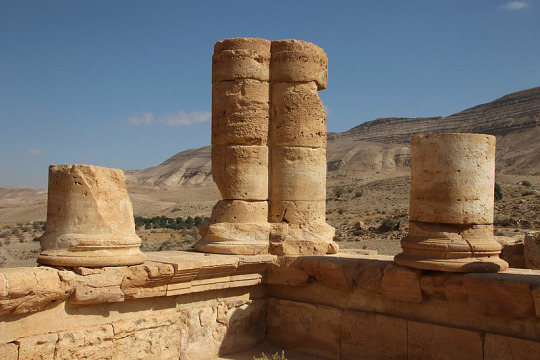


#art#Architecture#travel#history#jordan#temple#dushara#uzza#al uzza#nabatean#podium#heart column#corinthian#syrian pediment#grapevine#roman#arabia#nabatea#tetrastyle#naos#1 ce
87 notes
·
View notes
Photo

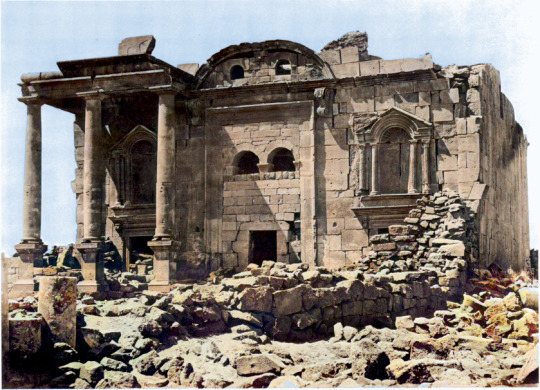

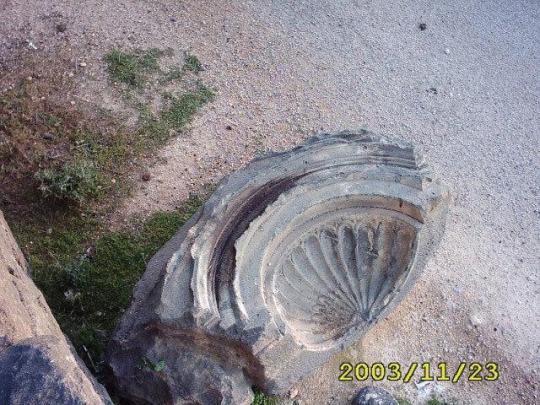
“The Praetorium”
Phaena (Al-Masmiyah), Trachon, Syria
160–169 CE
24.8 x 16.4 m
Along with the Roman temple dedicated to Tyche in nearby al-Sanamayn, the Praetorium of al-Masmiyah is the only Roman temple in the Levant that contains niches for statues in the cella. This unique feature in Roman architecture was likely inspired by pre-Roman architecture, particularly the temple of Baal-Shamin in the Syrian Desert town of Palmyra or in various Arabian cities.
The Praetorium was situated atop a podium in a temenos surrounded by colonnades and was constructed by the commander of the Third Gallic Legion between 160–169 CE during the reign of the Roman emperors Aurelius Antoninus and Lucius Aurelius Verus. It was relatively small, measuring 24.8 x 16.4 meters. It has a rectangular ground plan with a semi-circular apse that projects onto one side of the building opposite of the doorway. Both sides of the doorway contained niches reserved for statues. The interior space consisted of a single room, which was the naos, and measured 15.09 x 13.78 meters.
The Praetorium was formerly topped by a square domed roof, likely a cloister vault, which had since collapsed. The roof is supported by four free-standing columns fixed at the inner angles of cross-vaulted arches, which together form a Greek cross. On the opposite end of each columns stood a half-column, making for a total of four main columns, eight half-columns, and four quarter columns (situated at each corner) inside the naos. The arches sit on lintels that span the space between the outer wall and the columns supporting the roof. There were six niches against the walls that were reserved for the placement of statues and in the center of them was the main space, the adyton, used to hold the main statue of the pagan cult. The adyton was topped by a conch-shaped half-dome. The building had two windows, a rare feature in Classical pagan temples, and a total of three entryways. Of the entry ways, there was a principal central doorway that was higher and broader than the two side-doors.
that was constructed by the commander of the Third Gallic Legion between 160–169 CE during the reign of the Roman emperors Aurelius Antoninus and Lucius Aurelius Verus.
Sources: 1
#art#Architecture#syrian#semitic#temple#syrian gable#Phaena#Trachon#2 ce#doric#adyton#dome#conch#corinthian#Aurelius Antoninus#Lucius Aurelius Verus
64 notes
·
View notes
Photo



Kalybe of Il-Haiyat
Il-Haiyat, Trachon, Syria
2-3 century CE
The site is located in the east-east of the Tarkon, 7 km northwest of Laqqa. In front of us is a transverse structure, whose longitudinal axis is east-west.
The structure consisted of three halls arranged in one row, slightly identical in size. The main hall, which was apparently covered by a dome, opened to the north in an arched opening. The width of the opening is almost the same as the width of the hall. The main hall rose to a height of two storeys, while the two side halls were each divided horizontally into two storeys. The halls on the lower floor had small openings - an opening for each of the two halls - and on the second floor there were arranged windows above the openings. To the upper floor led the two staircases, placed in the thick walls that separated the main hall from the side halls. It is worth noting the existence of a semi-circular niche covered by a half-dome, which is unusually located, between the arch that crowns the central opening and the western window. The dimensions of the niche made it possible to place a statue in it.
Sources: 1, 2
49 notes
·
View notes
Photo
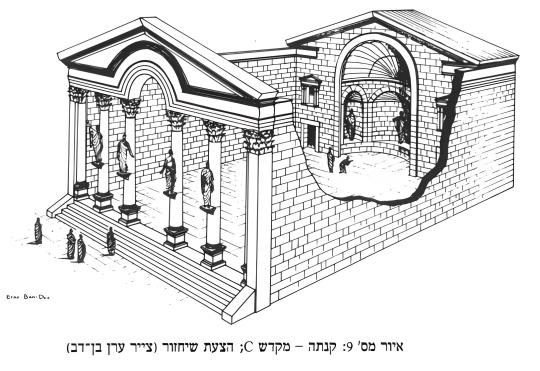



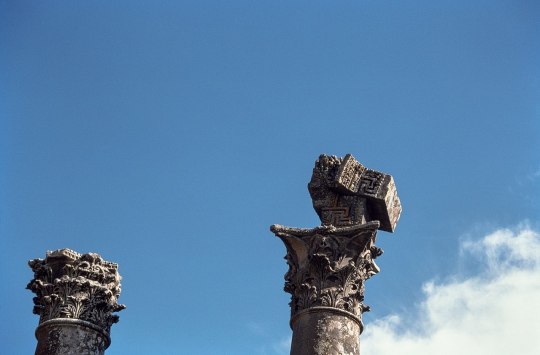

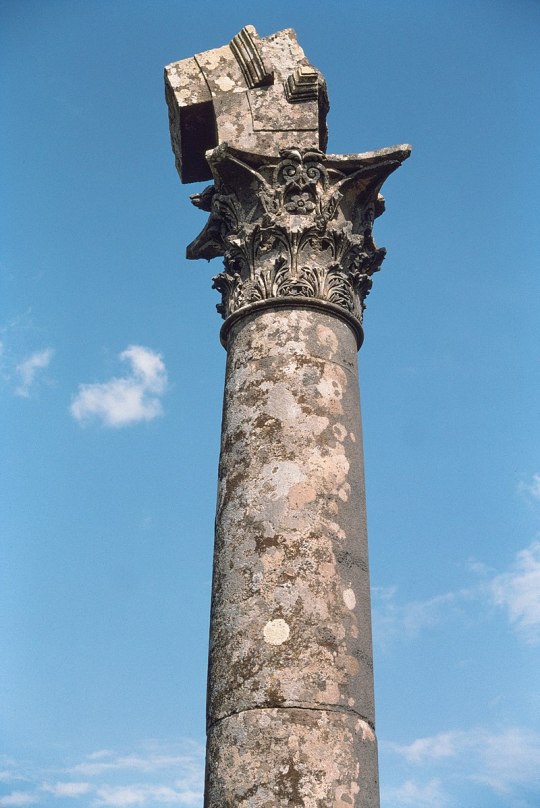
Temple C (Kalybe of Kanatha)
Kanatha (Qanawat), Hauran, Syria
2-3rd century CE
The Temple was a square structure, whose entrance façade, was made of of a four-pillar propylon, nestled between corner pillars facing north. This array, resembling the distyle in antis is quite rare in classical architecture. The four column had corbels designed for placing statues at about half their height. This decorative element is also quite rare in classical architecture, and is found only in a few sites in Syria. The space between the two main pillars in is greater than the spaces between the side pillars and it carried a Syrian gable, with its curve towards an arch is still visible.
The two long east and west walls of the temple were smooth. They stand behind the pilasters of the propylon and connect to the south wall of the temple, i.e. to a wall in the center of which is the apse. The southern wall, that is, the wall in front of the entrance, was designed as having a semicircular apse with adjacent rectangular rooms on both sides. Both rooms opened to the north, that is, towards the inner space of the temple.
Inside the rounded wall of the apse were three ornate niches, rounded in the outline, which were arranged symmetrically: a niche with a larger opening in the center and next to it smaller niches. The inner space of the temple, which is located between the apse wall and the propylon at the entrance, and between the two long walls wasn’t roofed. Entering the temple through the Syrian gable- crowned propylon, one would find himself standing in a rectangular plaza that stretched in front of the two-story wall with a semi-circular niche in the center, covered by a half-dome in which the emperor's statue stood.
A Kalybe (κάλὑβη) is a type of temple found in the Roman East dating from the first century and after. They were intended to serve as a public facade or stage-setting, solely for the display of statuary.They were essentially stage-sets for ritual enacted in front of them. The kalybe has been associated with the Imperial Cult.
below: remains of geometric wall painting on western conch of adyton
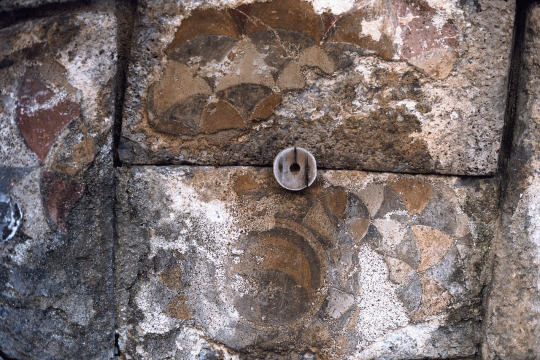
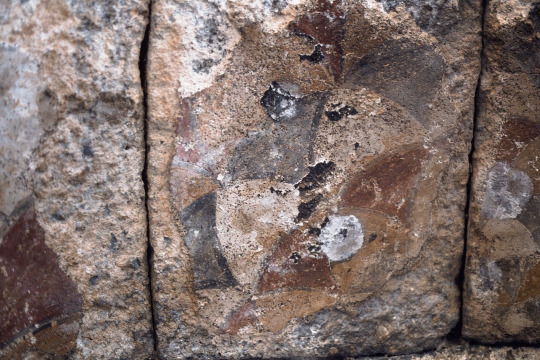
Sources: 1, 2, 3
#art#Architecture#travel#history#kalybe#hauran#syria#semitic#plaza#forum#emperor#niche#syrian pediment#corbel#corinthian#kanatha#qanawat#imperial cult
99 notes
·
View notes
Photo

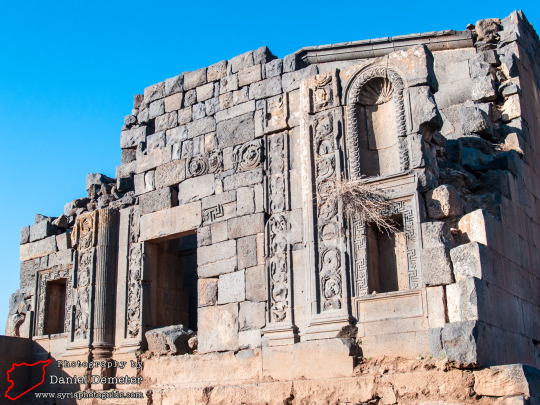
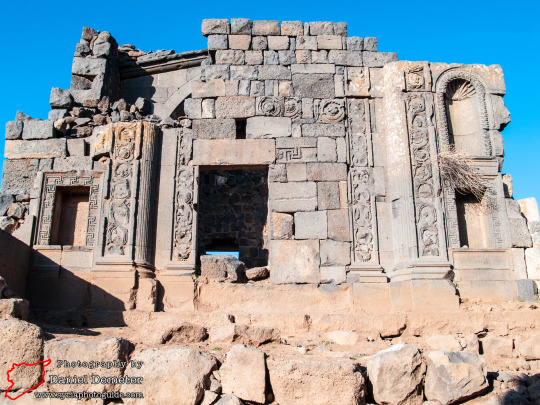
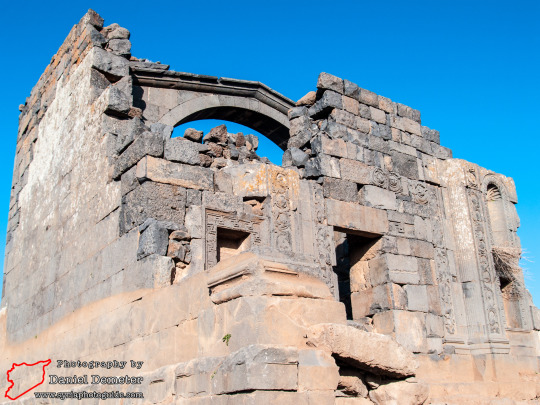
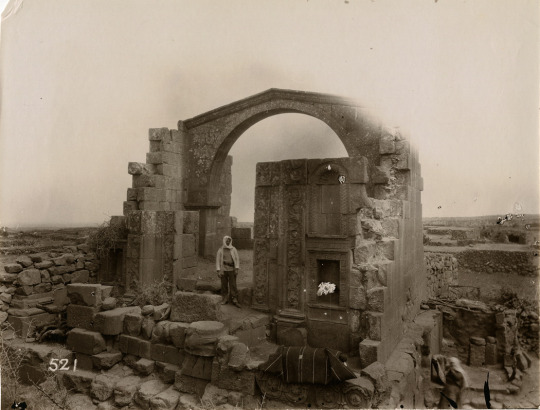

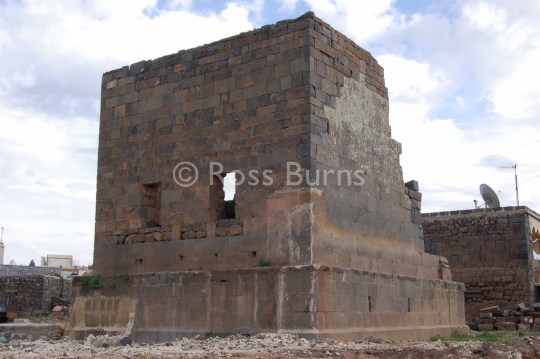

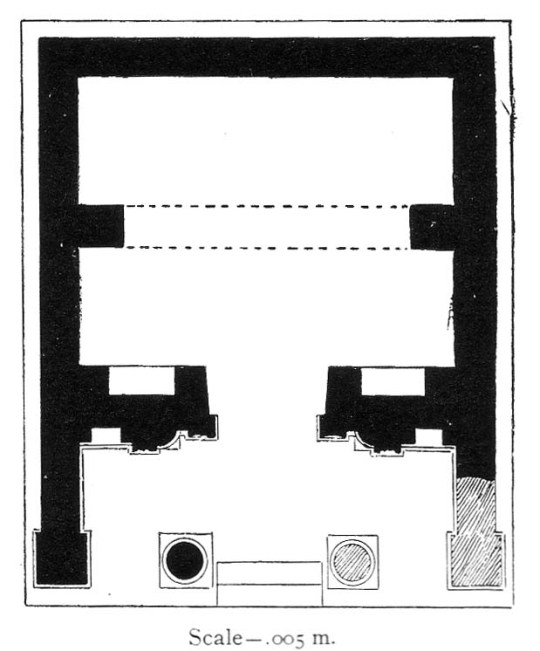

North Temple of Atil - Temple of Theandrites
Atil, Hauran, Syria
211–212 CE
This small town contains two almost identically designed Roman temples, delicately fashioned from the local basalt stone. The south Temple stems from the Antonine period (151 CE) the second or North Temple (probably dedicated to the Nabataean deity, Theandrites) was built in 211–212 CE. The southern temple is better preserved, while the northern temple has been incorporated into a modern house and tomb. Both have attractively decorated facades with fine detail.
Sources: 1, 2
#art#Architecture#travel#history#3 ce#hauran#syria#semitic#temple#atil#atel#tetrastyle#syrian pediment#corinth#meander#arch#niche#conch#pilaster
67 notes
·
View notes
Photo
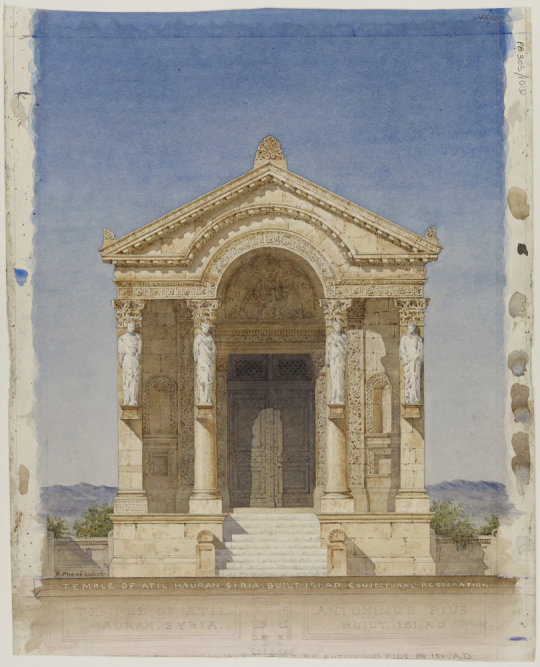

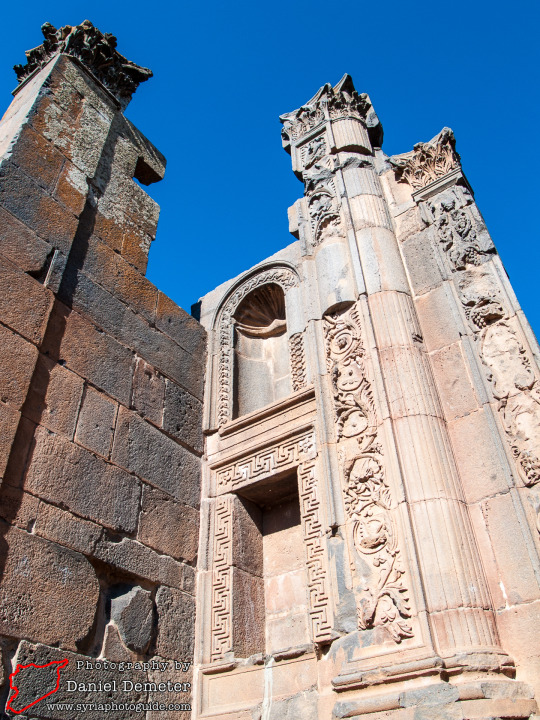





South Temple of Atil
Atil, Hauran, Syria
151 CE
This small town contains two almost identically designed Roman temples, delicately fashioned from the local basalt stone. The south Temple stems from the Antonine period (151 CE) the second or North Temple (probably dedicated to the Nabataean deity, Theandrites) was built in 211–212 CE.
The southern temple is better preserved, while the northern temple has been incorporated into a modern house and tomb. Both have attractively decorated facades with fine detail.
Closeup of the Greek inscription at Atil, Syria. The inscription dates the construction of the temple to the 14th year of the reign of Antoninius Pius (151 CE).
Sources: 1, 2
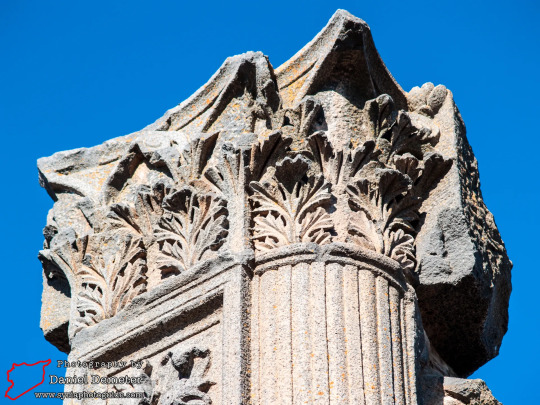
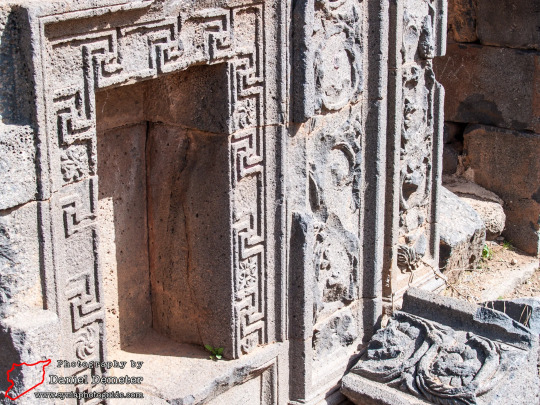
#art#Architecture#travel#history#2 ce#hauran#syria#temple#atil#atel#tetrastyle#syrian pediment#Antoninius Pius#corinthian#meander#niche#pilaster#conch
74 notes
·
View notes
Photo





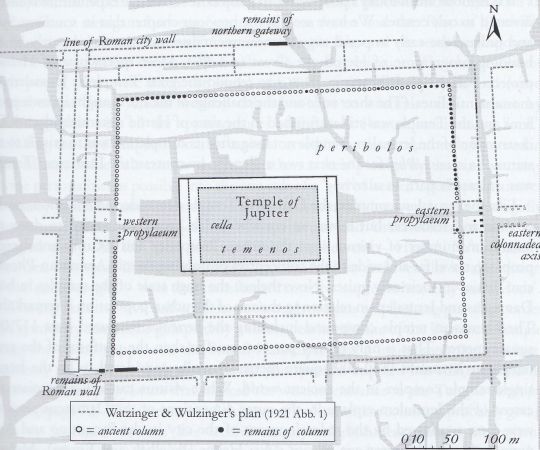
Temple of Jupiter
Damscus, Syria
1st century BCE - 3
Damascus was the capital of the Aramaean state Aram-Damascus during the Iron Age. The Arameans of western Syria followed the cult of Hadad-Ramman, the god of thunderstorms and rain, and erected a temple dedicated to him at the site of the present-day Umayyad Mosque. It is not known exactly how the temple looked, but it is believed to have followed the traditional Semitic-Canaanite architectural form, resembling the Temple of Jerusalem. The site likely consisted of a walled courtyard, a small chamber for worship, and a tower-like structure typically symbolizing the "high place" of storm gods, in this case Hadad.
The Temple of Hadad-Ramman continued to serve a central role in the city, and when the Romans conquered Damascus in 64 BCE. The Romans believed that each site (mountain, river, wood, etc.) had its own deities (genius loci); this approach led them to accept the beliefs of the countries they conquered; in the case they assimilated Hadad with their own god of thunder, Jupiter, and Hadad became Jupiter Damascenus (of Damascus)

Thus, they engaged in a project to reconfigure and expand the temple under the direction of Damascus-born architect Apollodorus, who created and executed the new design. The symmetry and dimensions of the new Greco-Roman Temple of Jupiter impressed the local population. With the exception of the much increased scale of the building, most of its original Semitic design was preserved; the walled courtyard was largely left intact. In the center of the courtyard stood the cella, an image of the god which followers would honor. There was one tower at each of courtyard's four corners. The towers were used for rituals in line with ancient Semitic religious traditions where sacrifices were made on high places.
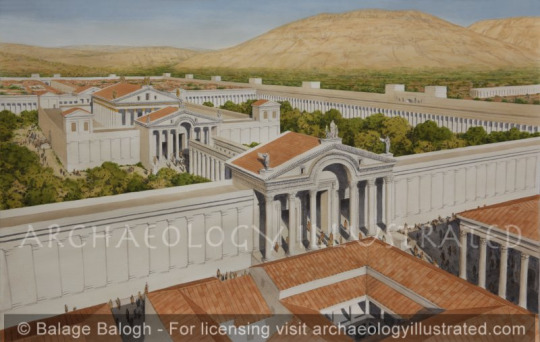

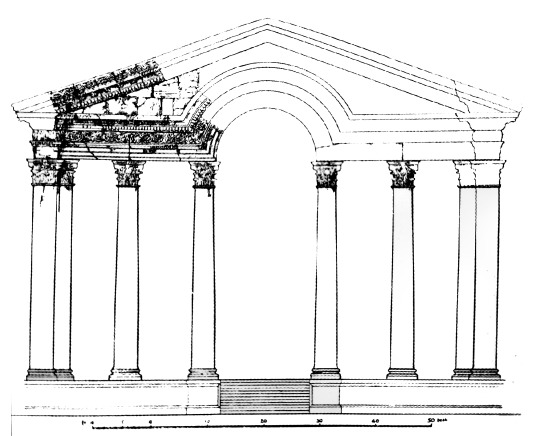


The importance of religion in the Greek-Roman world was not very significant; it is difficult to remember the name of a high priest in Greek or Roman history; at most the names of a clairvoyant such as Tiresias or an augur (a priest who interpreted the will of the gods) such as Calchas come to mind. Religion played a much greater role in Egypt and in the Near East; this may explain the size of the Temple to Jupiter in Damascus, which is enormous when compared to that of the whole town. It was preceded by two propylaea (entrances) which led to the peribolos, a high wall which surrounded the temenos, the sacred space where the actual temple was located.
The sheer size of the compound suggests that the religious hierarchy of the temple, sponsored by the Romans, wielded major influence in the city's affairs. The Roman temple, which later became the center of the Imperial cult of Jupiter, was intended to serve as a response to the Jewish temple in Jerusalem. Instead of being dedicated to one god, the Roman temple combined (interpretatio graeca) all of the gods affiliated with heaven that were worshipped in the region such as Hadad, Ba'al-Shamin and Dushara, into the "supreme-heavenly-astral Zeus". The Temple of Jupiter would attain further additions during the early period of Roman rule of the city, mostly initiated by high priests who collected contributions from the wealthy citizens of Damascus. The inner court, or temenos is believed to have been completed soon after the end of Augustus' reign in 14 CE. This was surrounded by an outer court, or peribolos which included a market, and was built in stages as funds permitted, and completed in the middle of the first century CE. At this time the eastern gateway or propylaeum was first built. This main gateway was later expanded during the reign of Septimius Severus (r. 193–211 CE). By the 4th century CE, the temple was especially renowned for its size and beauty. It was separated from the city by two sets of walls. The first, wider wall spanned a wide area that included a market, and the second wall surrounded the actual sanctuary of Jupiter. It was the largest temple in Roman Syria.
Southern entrance


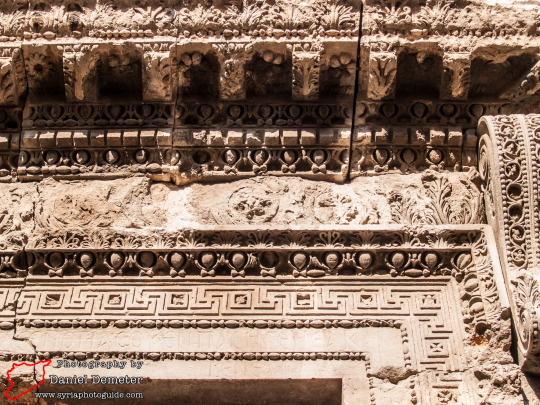
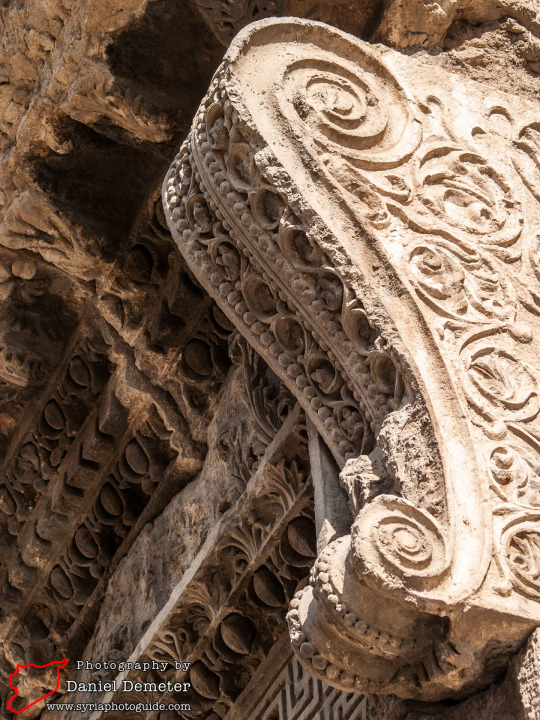


Eastern Propylon
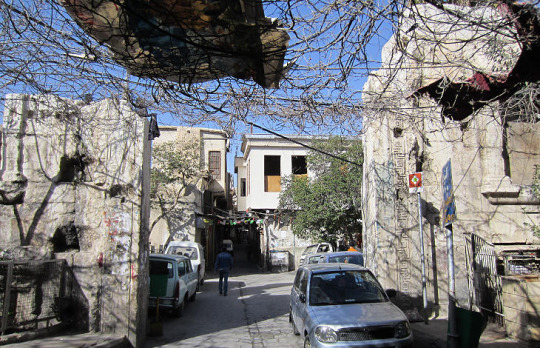



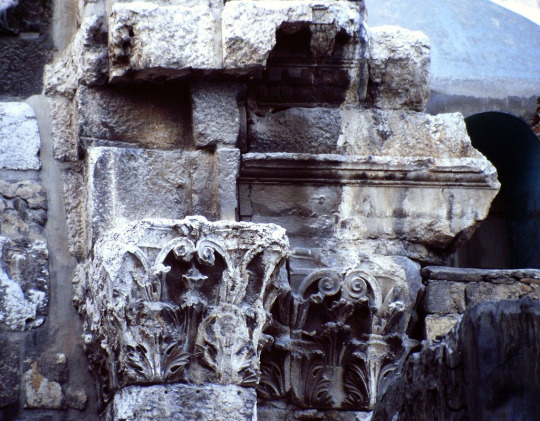
General ruins:
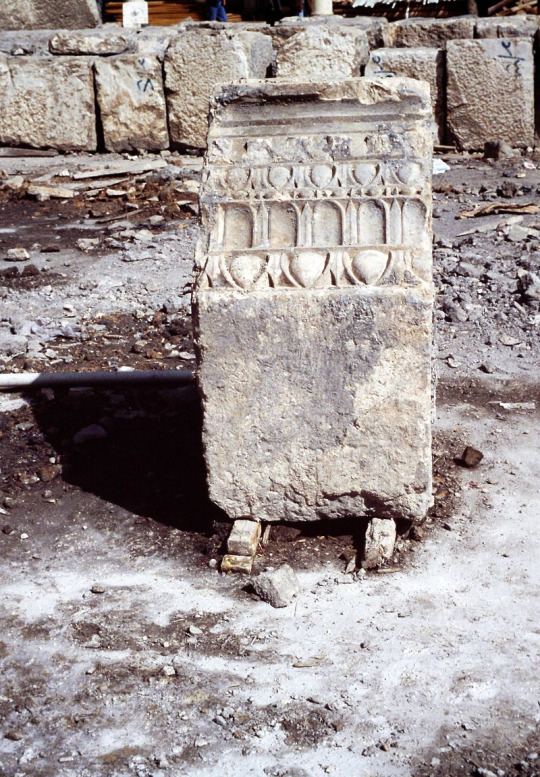



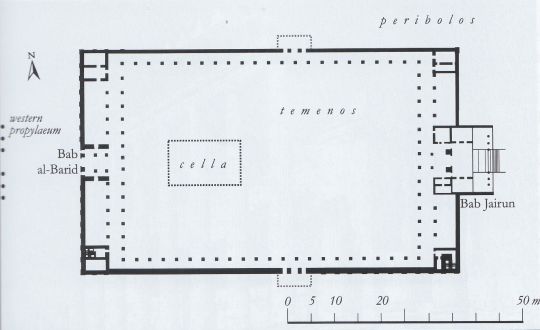
Sources:
1, 2, 3, 4, 5, 6
#art#Architecture#tarvel#history#temple#jupiter#damascus#syria#corinthian#Propylon#syrian pediment#1 bce#1 ce#2 ce#3 ce#meander#pilaster#semitic#haddad#hadad
110 notes
·
View notes
Note
Hi! What are the sources for your pictures (drawing and reconstructions of the monument) of the monument of the bulls? Thanks
The first two of them are of my own making. Today I know my reconstruction is not very true to the findings but I did my best with what I knew. More accurate reconstructions:

Constructing the Neorion at Delos, by Marek Szyszko.

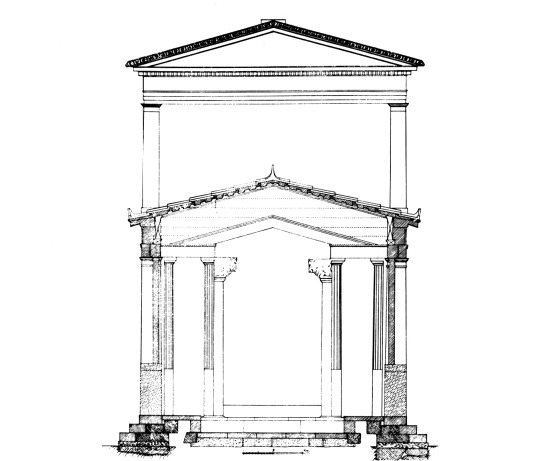

54 notes
·
View notes
Note
You've posted a picture of an artist's reconstruction of the Octagon in Ephesus against a background of the Library of Celcus. Can you tell me where this image comes from and who has the copyright? I'd like to use it in a story about Arsinoe.
The picture of the Octagon is taken from the ENCYCLOPAEDIA OF THE HELLENIC WORLD
8 notes
·
View notes
Text
I was asked about “epiphany windows” in the temple of Artemis in Magnesia. The ask was lost to Tumblr’s bad web design, but the answer I was able to find:
“Some Hellenistic temples in Asia Minor had “epiphany windows” in their pediments (e.g., Temple of Artemis at Magnesia-on-the-Maeander; Temple of Artemis at Ephesus), possibly used for staging dramas for a populace gathered below (on epiphanies, see Platt 2011). These would not have admitted light to the interiors but rather to the attic spaces behind the pediment (Figure15.3, 31.2)“
source

source
Hope that helped :)
17 notes
·
View notes
Note
How do I obtain permission to reproduce the Artist drawing of Paullus’ Monument for my forthcoming book (2022) on the last kings of Macedonia (OUP)? Thank you, Ian.worthington
Sorry for the late answer, the pictures aren't mine and aren't owned by me, and sadly I didn't record orderly my sources for the post back then. Would be glad to help you find any reconstructions with sources.
3 notes
·
View notes
Photo

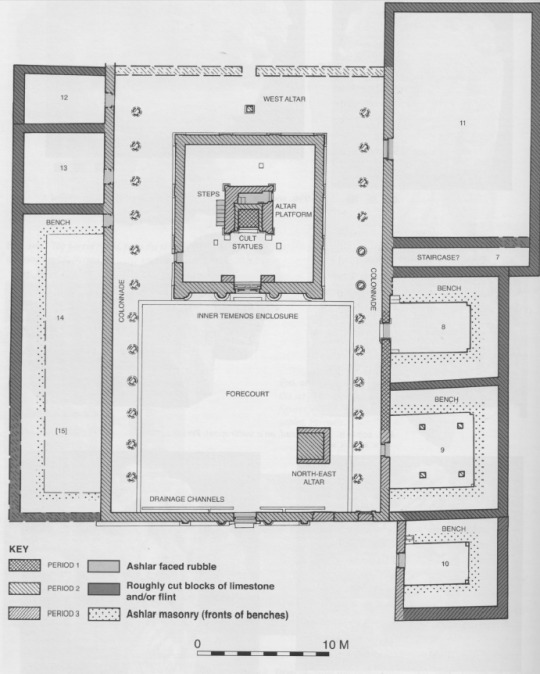

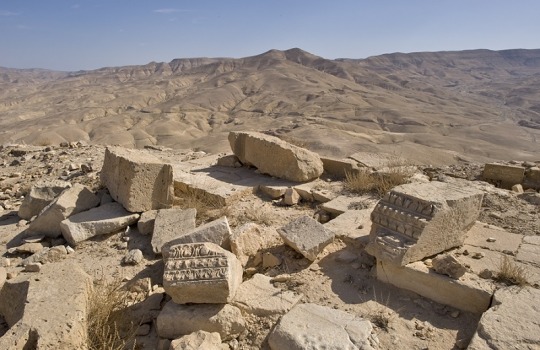
Khirbet et-Tannur
Jordan
2nd century BCE - 4th century CE
The Nabataean temple ruins atop of Jabal et-Tannur overlook the confluence of Wadi al-Hasa and Wadi La‘aban north of the modern town of Tafila. From the 2nd century BC through to the middle of the 4th century CE the sanctuary was an important pilgrimage place for the Nabataeans to worship, and celebrate seasonal rituals and banquets. With no spring for water supply, it was not a permanent settlement. It functioned in connection with the neighboring village and temple of Khirbet edh-Dharih, some 7 km south on the old caravan route coming from the capital city of Petra.
The sanctuary consisted of a temenos (temple enclosure), with a forecourt and roofed colonnaded walkways on the north and south sides connecting to rooms equipped with benches on three sides, called triclinium for resting and ritual banqueting.

The eastern façade of the inner temenos was also richly decorated. The famous relief known as the Vegetation Goddess, veiled by leaves and framed by flowers with an eagle above her comes from a semi-circular pediment over the main portal. Both sculptures are today on display at the Jordan Museum in Amman. Scholars suggest to see in her the goddess of the nearby spring of La‘aban. An inscription found on site dated 8 or 7 BC mentions building works dedicated by the guardian of this spring. After 2000 years, this name lives on in the name Wadi La‘aban, the river bed connecting Khirbet et-Tannur and Khirbet edh-Dharih.
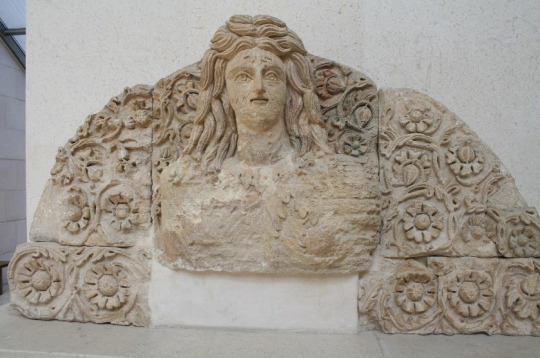


The inner temenos (sacred area) was an unroofed square enclosure (ca. 10 x 10 m) with an altar platform in the center that had a frontal niche to host the cult statues of the main god and goddess. A male cult figure holding a lightning bolt and flanked by bull calves was found during excavations, probably the supreme god Dushara with attributes and iconography adopted by the Nabataeans from neighbor cultures. From the goddess Allat only one foot and a part of her lion throne were found. Placed between them might have been the zodiac ring encircling a bust of a Tyche, carried by a winged Victory (Nike), another one of the famous discoveries at Khirbet et-Tannur. The upper zodiac piece is in the collection of the Cincinnati Art Museum, USA, together with the main cult statues. The sculptures date from the main construction phase of the first half of the 2nd century CE. The altar niche was surrounded by an elaborate decoration including busts also representing zodiac signs, from which two have survived: the personification of Pisces (in Amman) and Virgo (in Cincinnati).


A staircase led to the altar's roof, where a sacred flame was lit and animal sacrifices were burnt. Incense, grains and offering cakes were burnt as offerings on either side of the altar niche, and on smaller free-standing altars scattered around the site as well.
The east-west axis alignment of the sanctuary ensured that the rising sun would illuminate the altar niche during the spring and autumn equinoxes, when special rituals and celebrations took place to ensure agricultural abundance. The remains of ceramic lamps with nozzles on several levels suggest night-time processions and rituals to worship zodiacal deities appearing in the starry sky.

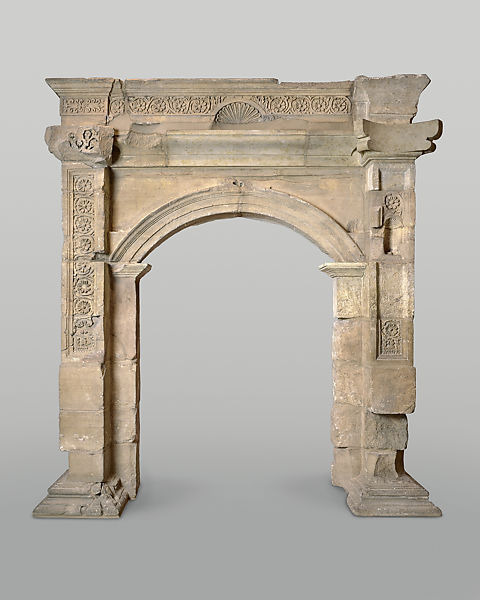
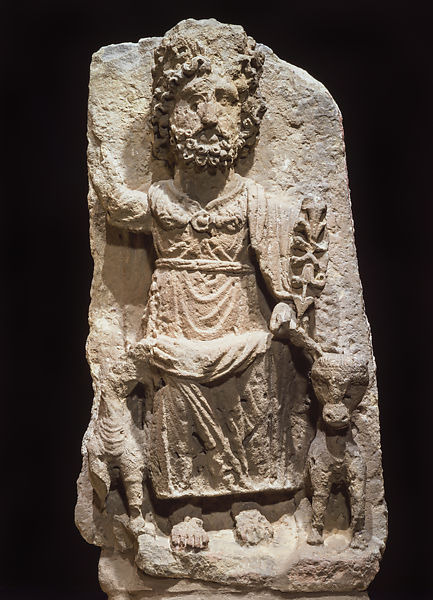


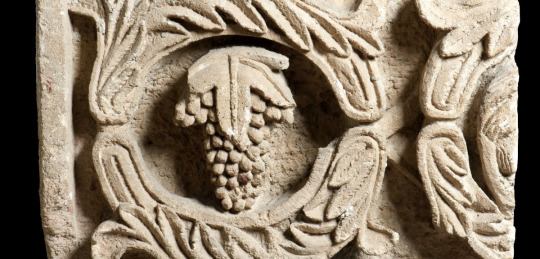
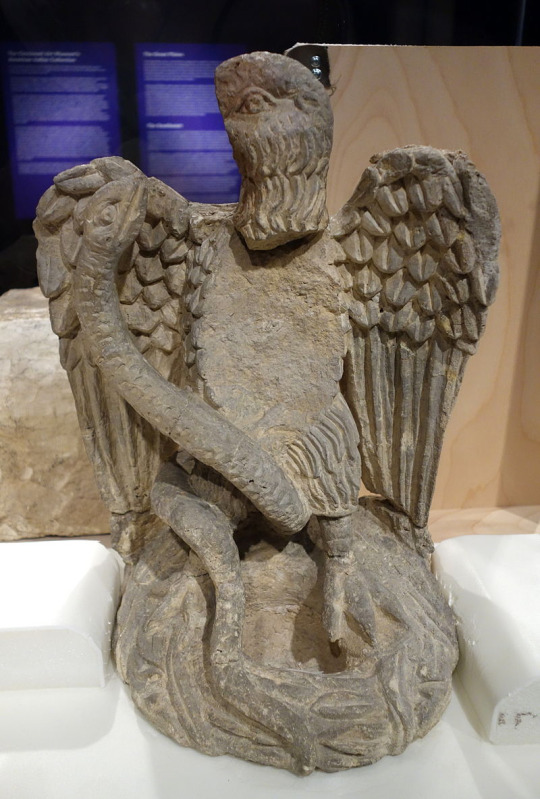
Sources: 1, 2, 3, 4, 5
#art#Architecture#travel#history#jordan#temple#altar#dushara#qos#allat#eagle#corinthian#temenos#2 bce#1 bce#1 c#2 ce#3 critically injured in san jose crash#4 ce#zodiac#thyce
173 notes
·
View notes
Photo

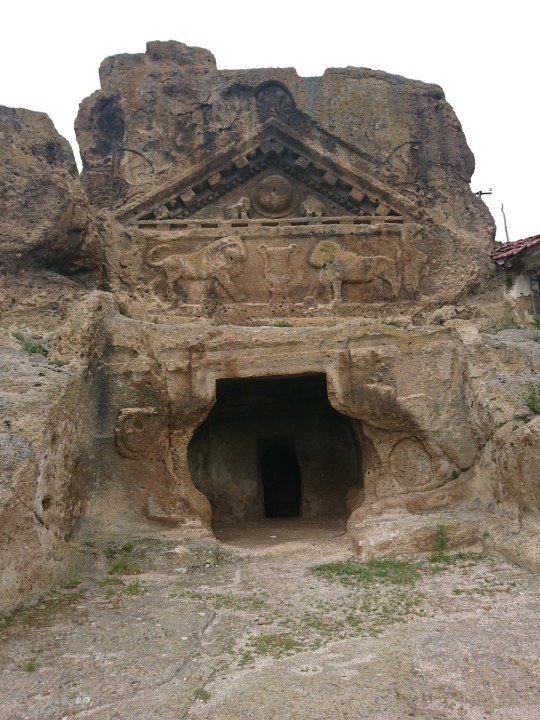
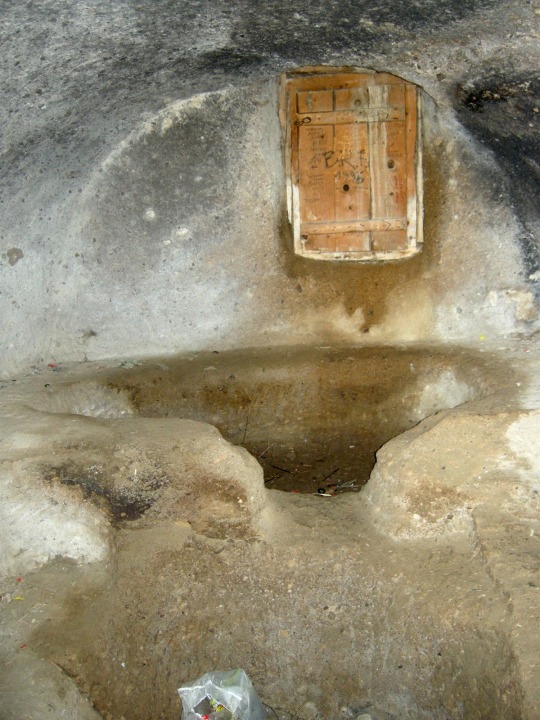
The Tomb of Solon
1-2 century CE~
Kümbet, Phrygian Valley, Asia minor (Turkey)
The Tomb of Solon is believed to date from the early Roman era, though its iconography (and inscriptions found at the sight) point at a mix of Phrygian and Roman culture. Following the decline of the Hittites, the Phrygians ruled western central Anatolia between roughly 1150 - 550 BCE, and continued to follow the core of their culture under the control of the Persians, Greeks and Romans.
From the courtyard in front of the tomb, there are stairs climbing both sides of the tomb, which lead to what looks like an alter in front of the frieze and pediment. The frieze is decorated with two lions facing each other, and guarding an urn that stands between them, which would representationally hold the remains of the deceased. In the center of the pediment is the representation of a shield, and what looks like a pair of horses, though they could be lions, hinting that the deceased had won his honor in battle.
Finely decorated acroterion can be seen at the peak of the roof, and on each of the roof corners. This truley is a magnificently decorated tomb, and according to inscriptions, was meant to house a man by the name of Solon.
Sources: 1, 2
#art#Architecture#travel#history#kumbet#asia minor#turkey#Phrygia#Phrygian#tomb#mausoleum#roman#1 ce#2 ce#lions#eagle#rock cut#acroterion#palmette
125 notes
·
View notes
Text

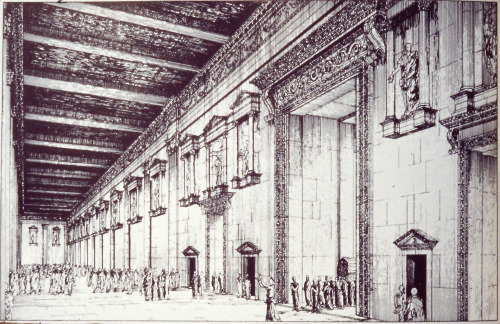

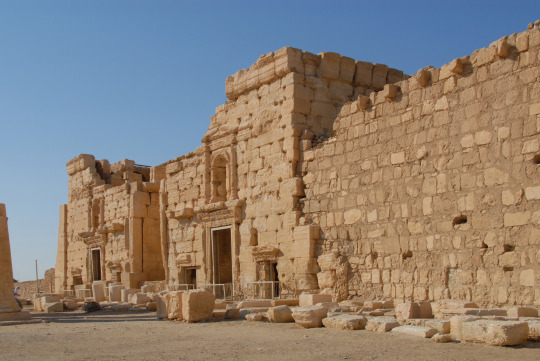
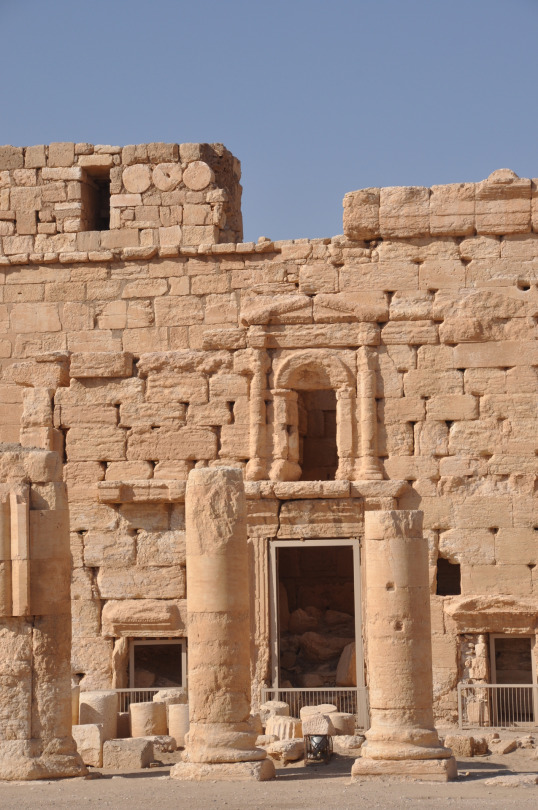

Temple of Bel (3D)
Palmyra (Tadmor), Syria
32 CE
Part I (exterior) || Part II (interior) || Part III (surrounding precinct)
The Temple of Bel (Baal) was a temple located in Palmyra, and consecrated to the Mesopotamian god Bel, worshipped at Palmyra in triad with the lunar god Aglibol and the sun god Yarhibol, who together formed the center of religious life in Palmyra.
The temple was built on a tell with stratification indicating human occupation that goes back to the third millennium BCE. The area was occupied in pre-Roman periods with a former temple that is usually referred to as "the first temple of Bel" and "the Hellenistic temple". The walls of the temenos and propylaea were constructed in the late first and the first half of the second century CE. The names of three Greeks who worked on the construction of the temple of Bel are known through inscriptions, including a probably Greek architect named Alexandras (Greek: Αλεξάνδρας). However, many Palmyrenes adopted Greco-Roman names and native citizens with the name Alexander are attested in the city.
A discussion of its architectural features demonstrates both the plurality of artistic and architectural styles in the ancient Mediterranean, and the numerous cultures that frequently overlapped and inter-mixed there. Although an inscription attests to the temple’s dedication in 32 CE, its completion was gradual with major architectural elements added over the course of the first and second centuries.
The organization of the temple's ground plan derive from the traditions of eastern ritual architecture, including independent shrines for distinct divinities and, notably, the bent-axis approach to the cult (i.e. the architecture requires the celebrant to enter the temple and turn 90 degrees in order to view the offering table and cult area). The architectural elements employed in the temple's elevation however, derive from the Graeco-Roman canon, including the use of the Corinthian order as well as various architectural elements of that adorn the frieze course and roofline .In its outward appearance, the temple seems to derive from the canon of Hellenistic Greek architecture .The temple itself sits within a bounded, architectural precinct measuring approximately 205 meters per side. This precinct, surrounded by a portico (a colonnaded entryway), encloses the temple of Bel as well as other cult buildings. The temple itself has a very deep foundation that supports a stepped platform. At the level of the stylobate (the platform atop the steps) the area measures 55 x 30 meters and the cella (the inner chamber of the temple that held the cult statue), stands over 14 meters in height and measures 39.45 x 13.86 meters.
Palmyra's remarkable 2,000-year-old Temple of Bel was demolished in an atrocious crime against mankind and history in August 2015 by the Islamic militant group ISIS. (post-destruction 3D)
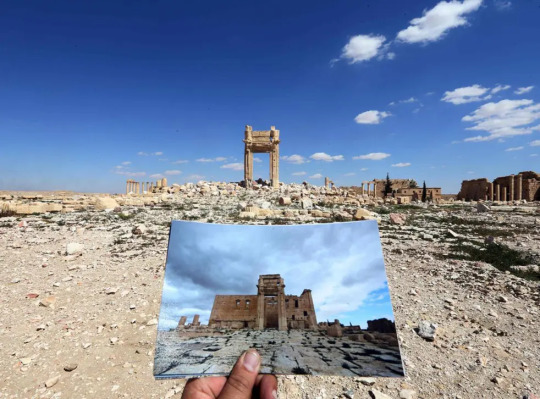

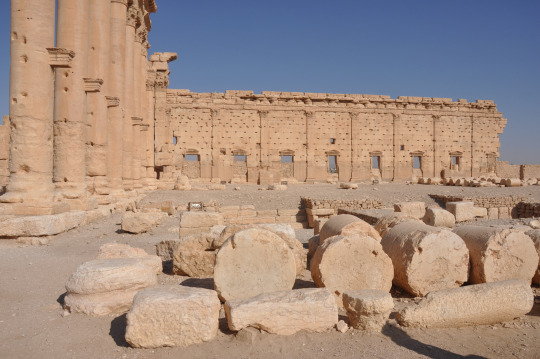
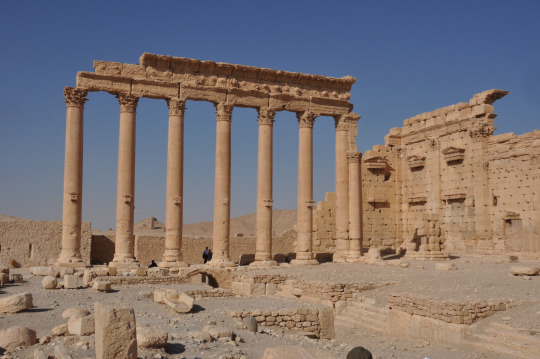

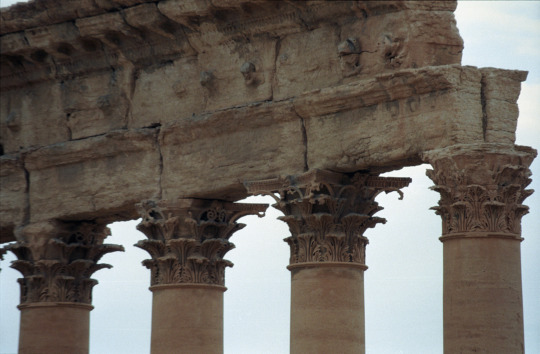
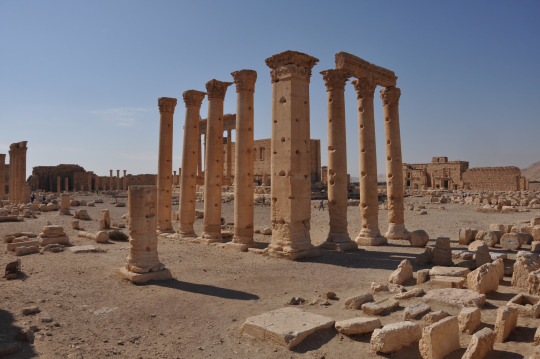
Fragments in the courtyard
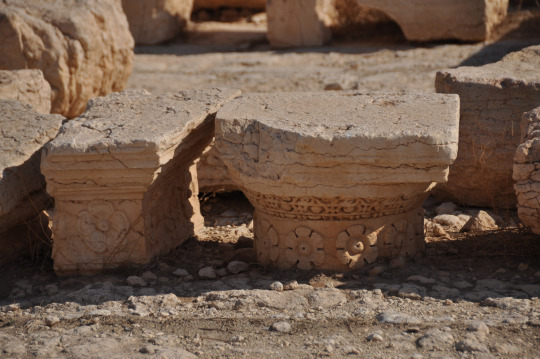
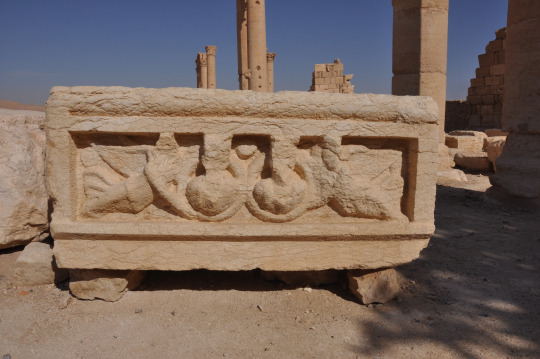
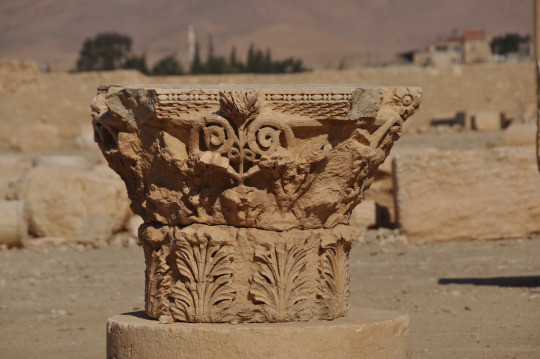

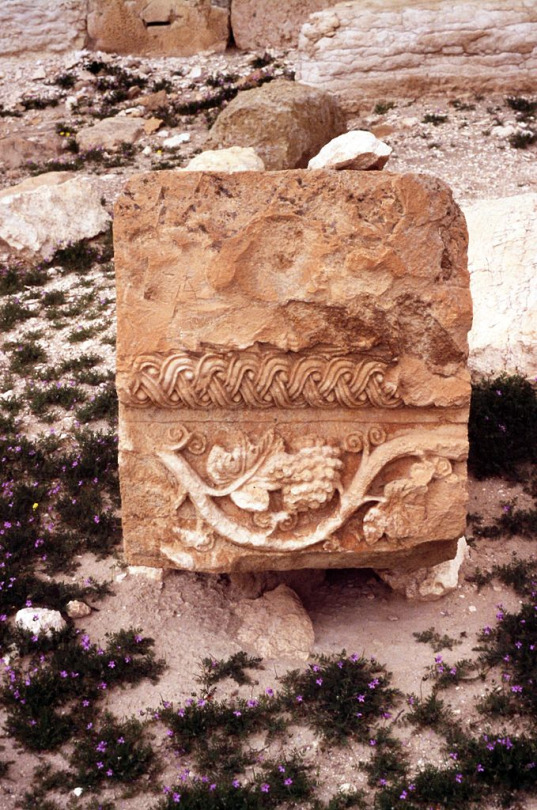
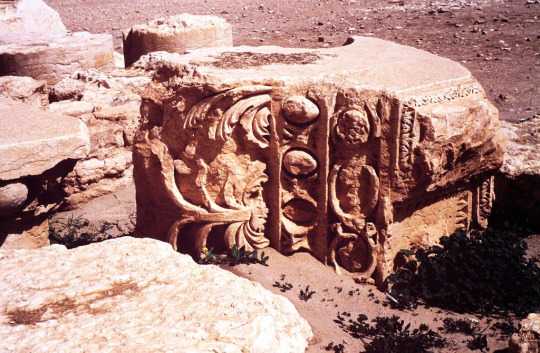

Sources: 1, 2, 3
#art#Architecture#travel#history#palmyra#tadmor#tadmur#bel#Lebanese#syria#yarhibol#aglibol#1 ce#2 ce#3 ce#corinthian#mythology#grapevine#Propylaea#Propylon#gate
208 notes
·
View notes
Text
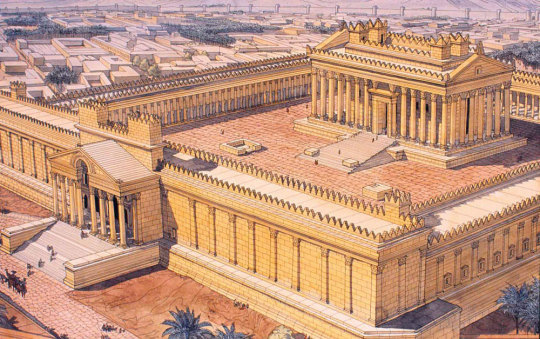

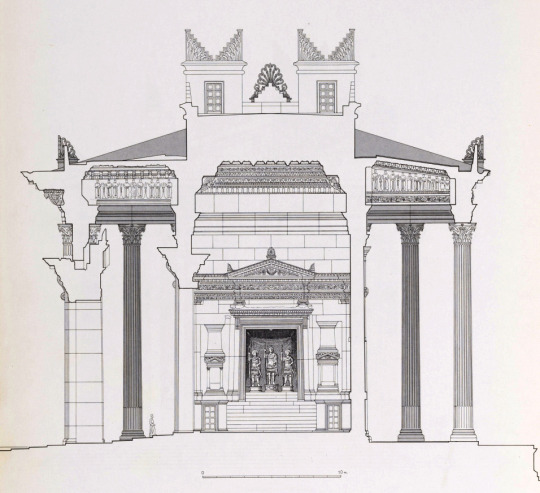

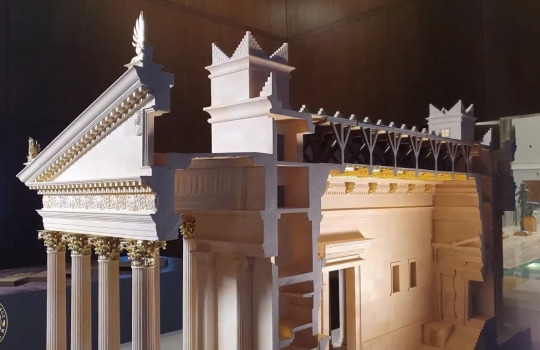
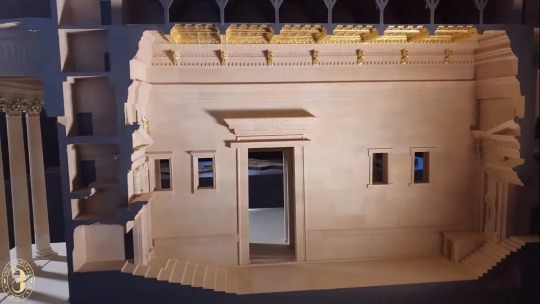

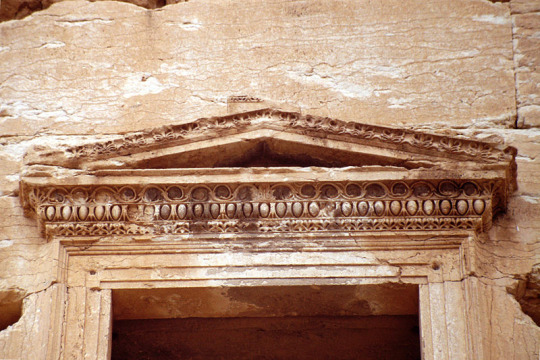

Temple of Bel (3D)
Palmyra (Tadmor), Syria
32 CE
Part I (exterior) || Part II (interior) || Part III (surrounding precinct)
The Temple of Bel (Baal) was a temple located in Palmyra and consecrated to the Mesopotamian god Bel, worshipped at Palmyra in a triad with the lunar god Aglibol and the sun god Yarhibol, who together formed the center of religious life in Palmyra.
A discussion of its architectural features demonstrates both the plurality of artistic and architectural styles in the ancient Mediterranean and the numerous cultures that frequently overlapped and inter-mixed there. Although an inscription attests to the temple’s dedication in 32 CE, its completion was gradual with major architectural elements added over the course of the first and second centuries.
The cella is designed according to the Near Eastern tradition of the bent-axis approach and incorporates two separate shrines (thalamoi). A ramp and central stair, with an off-center doorway, grants access to the cella. The columnar arrangement is pseduoperipteral (free-standing columns at the porch with engaged columns on the sides and back) and includes an arrangement of 8 x 15 (height = 15.81 meters) fluted, Corinthian columns. The cella also has exterior Ionic half-columns at each of its ends. Merlons (crenellations) crowded the roof and the ceilings were coffered. From masons’ marks and graffiti found on the site, it seems that there were craftspeople of various background, including Greeks and Romans alongside the Palmyrenes.
Both the North and the South chambers had monolithic ceilings. The Northern chamber’s ceiling highlighted seven planets surrounded by twelve zodiac carvings as well as a camel procession, a veiled women, and what is believed to be Makkabel, the god of fertility.
Palmyra's remarkable 2,000-year-old Temple of Bel was demolished in an atrocious crime against mankind and history in August 2015 by the Islamic militant group ISIS. (post-destruction 3D)
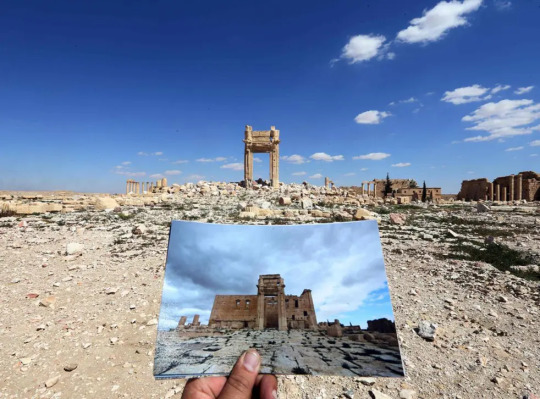
Sources: 1, 2, 3
North adyton (3D)
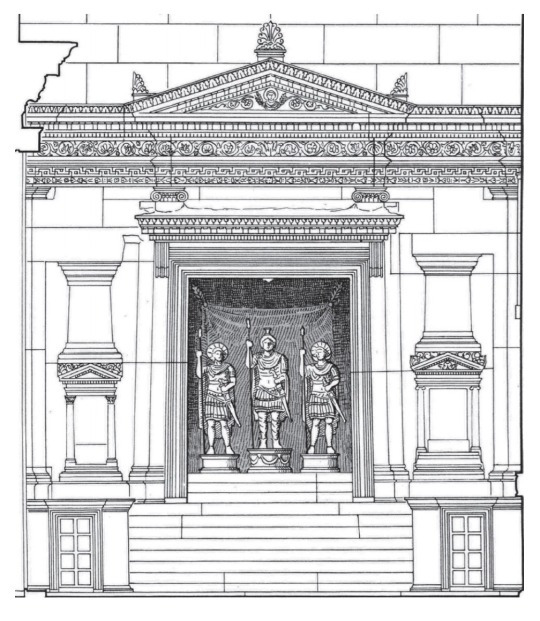



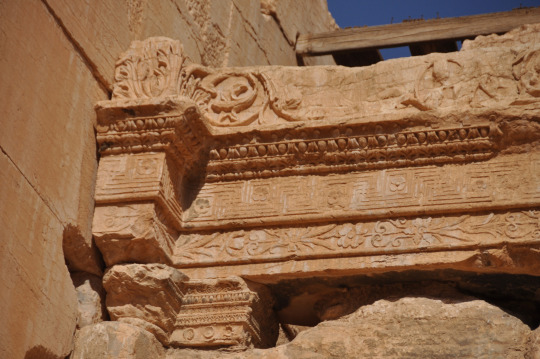


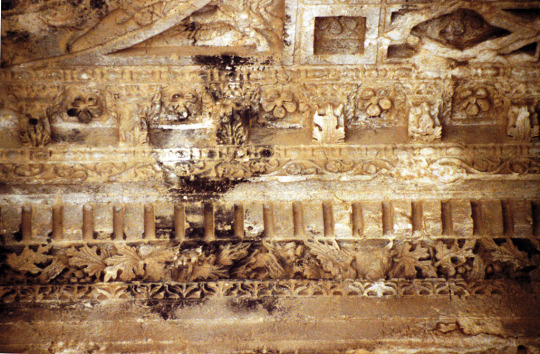
South Adyton (3D)




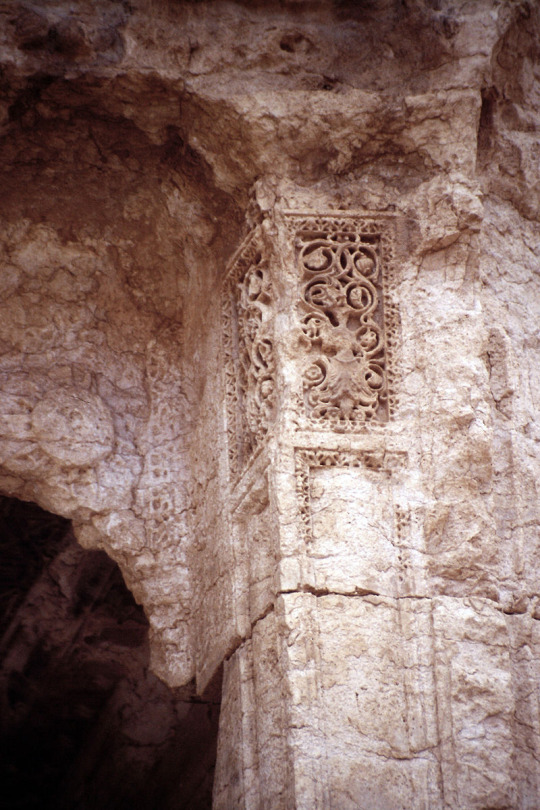


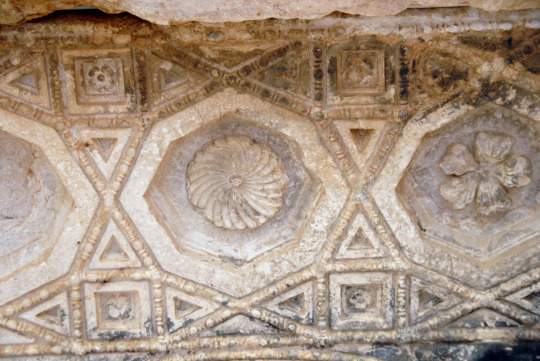
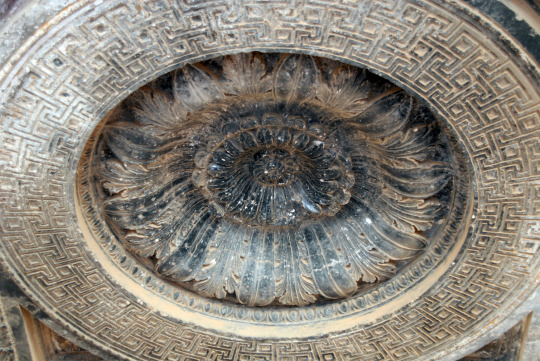
Art
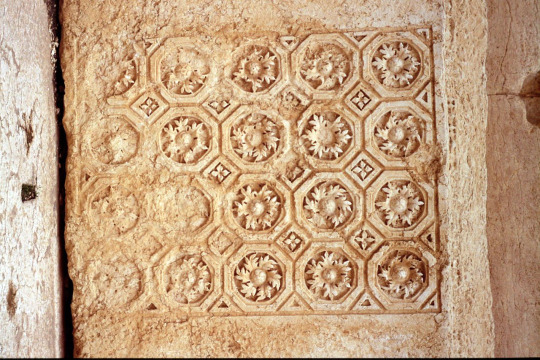

#art#Architecture#travel#history#palmyra#tadmor#tadmur#corinthian#adyton#cella#peripteral#temple#bel#baal#yarhibol#aglibol#1 ce#2 ce#3 ce#ceiling#zodiac#mythology#sanctuary#ionic
492 notes
·
View notes